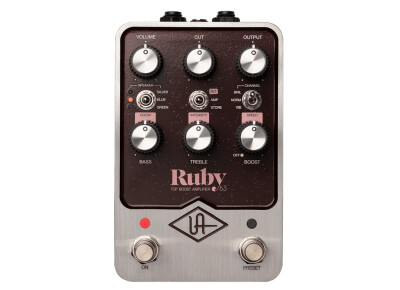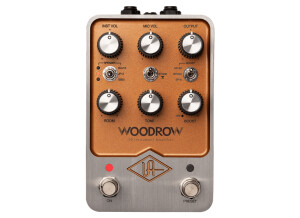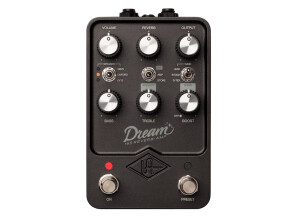Where to buy Ruby '63 Top Boost Amplifier?
Less
Best new price
See more offers
Tech. sheet
- Manufacturer: Universal Audio
- Model: Ruby '63 Top Boost Amplifier
- Series: UAFX
- Category: Guitar Amp Simulation Pedals
- Package weight:806 g
- Other names:ruby 63 topboostamplifier, ruby63topboostamplifier, ruby63 topboostamplifier, ruby63 top boost amplifier, ruby 63top boost amplifier
We have no technical specifications for this product
but your help will be much welcomed
Distributed by Universal Audio USA
»
Videos
User reviews
5.0/5(1 reviews)
5
100 %
4
3
2
1
Complete Amp-in-a-Pedal that Emulates Incredibly Well
Published on 05/19/23 at 05:10After having UA’s Woodrow ’55 (Fender Tweed amp emulation) for only a few hours, I knew I had to review the Ruby ‘63 (Vox AC30) and Dream ’65 (Fender Reverb Twin), the latter of which I will be done soon. These are a true joy to use because they sound so authentic, which makes it fun to review.
Now, the Ruby ’63 includes three amps, which is a lot of quality tones, and without considering the six speaker emulations included. The amp types are an AC30 Normal, which was a standard with Rory Gallagher, and then later Brian May. There also is the higher-gain Brilliant AC30, as well as a Vibrato amp selection (which is more of a Tremolo and not vibrato, as with the Dream ‘65). Both the...…
Now, the Ruby ’63 includes three amps, which is a lot of quality tones, and without considering the six speaker emulations included. The amp types are an AC30 Normal, which was a standard with Rory Gallagher, and then later Brian May. There also is the higher-gain Brilliant AC30, as well as a Vibrato amp selection (which is more of a Tremolo and not vibrato, as with the Dream ‘65). Both the...…
Read more
After having UA’s Woodrow ’55 (Fender Tweed amp emulation) for only a few hours, I knew I had to review the Ruby ‘63 (Vox AC30) and Dream ’65 (Fender Reverb Twin), the latter of which I will be done soon. These are a true joy to use because they sound so authentic, which makes it fun to review.
Now, the Ruby ’63 includes three amps, which is a lot of quality tones, and without considering the six speaker emulations included. The amp types are an AC30 Normal, which was a standard with Rory Gallagher, and then later Brian May. There also is the higher-gain Brilliant AC30, as well as a Vibrato amp selection (which is more of a Tremolo and not vibrato, as with the Dream ‘65). Both the Normal and Vibrato amps’ EQ are controlled by a single Cut knob, which allows you to ‘cut’ the degree of bass in the signal (Brian May has this set all the way left for maximum treble, since the tone of the Normal AC30 is dark with plenty of thick mid-range). The Brilliant amp’s EQ includes the Cut knob, but also the Bass and Treble functions –Treble knob becomes Tremolo Rate and the Boost knob becomes Tremolo Intensity when using the Vibrato amp. This may seem confusing, but the video included demonstrates how various knobs are shared and have different functions among amp types.
The six speaker emulations range considerably, from a brighter, thinner sound to a robust and heavier sound. I think there is something for nearly every taste out there, but you can bypass the built-in speakers and go direct to a preferred IR. What I like about the speaker variety is that some do not sound that good with a few of my guitars, yet they sound very usable or quite good with other guitars, much of which has to do with single-coil vs. humbucker, bright pickups vs. dark pickups, or style of playing/tone you are trying to achieve. UA knew this going in, that we all have different tastes, even if liking the same amp… and they sound great!
The video demo goes through several settings and functions, but I will address some of the other aspects. The EQ sections, including the Cut knob, all are sufficient, in that they range the bass, mids and treble very effectively without exaggeration – no heavy bottom end or boom, and no shrill top end (the Brilliant amp is brighter, but not harsh or brittle). There is a Room knob (which doubles as the Bass EQ knob) that provides studio or room ambience, and it is a nice feature for clean to slightly dirty sounds, particularly for that old Rock ‘n Roll or Rockabilly type comping; and it adds a slightly different dimension when coupled with a reverb or a slap-back echo. The Boost is very effective (which doubles as the Vibrato amp’s Tremolo Intensity) and it produces a very natural sounding gain as the amp responds accordingly. This sounds more like how an amp behaves, with that great break-up tone when cranked and digging in, as opposed to a saturated OD effect.
There are so many advantages to UA’s Ruby ’63, and this holds true of their other amp emulations. It is small and compact, which means bringing it to a gig and going direct to a mixer or powered amp. It can be integrated into an amp via the 4-cable method so that you can turn your Marshall, Fender, etc., into an AC30 at the click of a switch. You have access to three different AC30 models, along with various speakers/cabs, which would cost thousands of dollars to replicate with the real thing (particularly if you were to hunt down the vintage models, which these emulations were created upon). In that regard, the price of the Ruby ’63 may be considered a pricey boutique ‘pedal,’ but it is more than just a pedal – it is your amp and primary tone source that fits on a pedalboard. It is well constructed with a good heft and there this is obvious quality when you hold it or work the controls. And it certainly is eye-catching (sound should be the only thing that matters, but musicians still want attractive or cool-looking gear).
There are a few drawbacks, and price may restrict some buyers, particularly if they already have an amp (or amps) and may be content in that regard… others may bite at it due to curiosity or hopes of replacing a heavy, bulky amp combo. Still, other concerns from musicians tend to be “lack of MIDI,” or “lack of FX Loop,” etc. However, these were created to emulate classic amps and what functions they had available in their original format. Woodrow ’55 was an exception, as a ‘Mic Level’ knob was added, to give some heat/gain from that perspective. Regardless, some may be put off that only one preset can be saved, which you can toggle back-and-forth from the ’on’ settings you have dialed in, and this is how a two-channel amp would work anyway. The Preset could be clean (for example), whereas you set up the pedal for a crunch or something dirty. And if you wanted higher gain for lead or a heavier crunch, you step on an external boost/OD/fuzz/distortion. As well, you cannot add in the Tremolo to the Brilliant channel, nor can you add Boost to the Vibrato (since the Boost knob becomes Tremolo Intensity) – it is meant to be played clean. The only other drawback, which really is not as such, is that you require 400mA to power it. Most power supplies can handle this, but it depends what other power-hungry pedals are on your board. Regular combo amps have to be plugged in, and so, a wall-wart is a solution.
Overall, if you consider the Ruby ’63 to be a classic amp, and that you get three of them (plus the speakers) under one chassis, then it is easier to appreciate what the product is and what it is supposed to offer. You lose out on a few modern additions (tech that came about long after these amps), but are giving up those features for mind-blowing sound and likely the best AC30 emulation to date.
Now, the Ruby ’63 includes three amps, which is a lot of quality tones, and without considering the six speaker emulations included. The amp types are an AC30 Normal, which was a standard with Rory Gallagher, and then later Brian May. There also is the higher-gain Brilliant AC30, as well as a Vibrato amp selection (which is more of a Tremolo and not vibrato, as with the Dream ‘65). Both the Normal and Vibrato amps’ EQ are controlled by a single Cut knob, which allows you to ‘cut’ the degree of bass in the signal (Brian May has this set all the way left for maximum treble, since the tone of the Normal AC30 is dark with plenty of thick mid-range). The Brilliant amp’s EQ includes the Cut knob, but also the Bass and Treble functions –Treble knob becomes Tremolo Rate and the Boost knob becomes Tremolo Intensity when using the Vibrato amp. This may seem confusing, but the video included demonstrates how various knobs are shared and have different functions among amp types.
The six speaker emulations range considerably, from a brighter, thinner sound to a robust and heavier sound. I think there is something for nearly every taste out there, but you can bypass the built-in speakers and go direct to a preferred IR. What I like about the speaker variety is that some do not sound that good with a few of my guitars, yet they sound very usable or quite good with other guitars, much of which has to do with single-coil vs. humbucker, bright pickups vs. dark pickups, or style of playing/tone you are trying to achieve. UA knew this going in, that we all have different tastes, even if liking the same amp… and they sound great!
The video demo goes through several settings and functions, but I will address some of the other aspects. The EQ sections, including the Cut knob, all are sufficient, in that they range the bass, mids and treble very effectively without exaggeration – no heavy bottom end or boom, and no shrill top end (the Brilliant amp is brighter, but not harsh or brittle). There is a Room knob (which doubles as the Bass EQ knob) that provides studio or room ambience, and it is a nice feature for clean to slightly dirty sounds, particularly for that old Rock ‘n Roll or Rockabilly type comping; and it adds a slightly different dimension when coupled with a reverb or a slap-back echo. The Boost is very effective (which doubles as the Vibrato amp’s Tremolo Intensity) and it produces a very natural sounding gain as the amp responds accordingly. This sounds more like how an amp behaves, with that great break-up tone when cranked and digging in, as opposed to a saturated OD effect.
There are so many advantages to UA’s Ruby ’63, and this holds true of their other amp emulations. It is small and compact, which means bringing it to a gig and going direct to a mixer or powered amp. It can be integrated into an amp via the 4-cable method so that you can turn your Marshall, Fender, etc., into an AC30 at the click of a switch. You have access to three different AC30 models, along with various speakers/cabs, which would cost thousands of dollars to replicate with the real thing (particularly if you were to hunt down the vintage models, which these emulations were created upon). In that regard, the price of the Ruby ’63 may be considered a pricey boutique ‘pedal,’ but it is more than just a pedal – it is your amp and primary tone source that fits on a pedalboard. It is well constructed with a good heft and there this is obvious quality when you hold it or work the controls. And it certainly is eye-catching (sound should be the only thing that matters, but musicians still want attractive or cool-looking gear).
There are a few drawbacks, and price may restrict some buyers, particularly if they already have an amp (or amps) and may be content in that regard… others may bite at it due to curiosity or hopes of replacing a heavy, bulky amp combo. Still, other concerns from musicians tend to be “lack of MIDI,” or “lack of FX Loop,” etc. However, these were created to emulate classic amps and what functions they had available in their original format. Woodrow ’55 was an exception, as a ‘Mic Level’ knob was added, to give some heat/gain from that perspective. Regardless, some may be put off that only one preset can be saved, which you can toggle back-and-forth from the ’on’ settings you have dialed in, and this is how a two-channel amp would work anyway. The Preset could be clean (for example), whereas you set up the pedal for a crunch or something dirty. And if you wanted higher gain for lead or a heavier crunch, you step on an external boost/OD/fuzz/distortion. As well, you cannot add in the Tremolo to the Brilliant channel, nor can you add Boost to the Vibrato (since the Boost knob becomes Tremolo Intensity) – it is meant to be played clean. The only other drawback, which really is not as such, is that you require 400mA to power it. Most power supplies can handle this, but it depends what other power-hungry pedals are on your board. Regular combo amps have to be plugged in, and so, a wall-wart is a solution.
Overall, if you consider the Ruby ’63 to be a classic amp, and that you get three of them (plus the speakers) under one chassis, then it is easier to appreciate what the product is and what it is supposed to offer. You lose out on a few modern additions (tech that came about long after these amps), but are giving up those features for mind-blowing sound and likely the best AC30 emulation to date.
See less
00
»
Other Universal Audio guitar Amp Simulation Pedals
Other categories in Guitar Amp Simulators
Where to buy Ruby '63 Top Boost Amplifier?
Less
Best new price
See more offers














